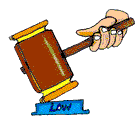 Introduction
to Law Lesson Plan
Introduction
to Law Lesson Plan
Materials:
Procedure:
Teachers - outlined below are various points to discuss. Adding "real life" examples and ideas are important, as well as a class discussion around each idea.
For example: introduce the concept of law by discussing what would happen to a society, or at school, or a business, if there were no laws. Chaos, confusion, and how our society as we know it would cease to exist are some of the points to discuss.
1. What is Law?
A. Historically, many philosophers, historians, sociologists, and political scientists have tried to accurately define law.
B. Aristotle (384 - 322 B.C.) took his cue from the Greek system that the world was ordered by a natural law. He tried to combine moral principles with legal principles into the "ideal", or natural law.
C. St. Thomas Aquinas (1224-1274) shared the "ideal law" view with Aristotle, but defined law as a transcendent law.
Law is defined as a rule of conduct or action prescribed or formally recognized as binding and enforced by a controlling authority. Opposite: lawless - not controlled by law; unruly; illegal.
Jurisprudence - the formal science of positive law.
2. Legal Systems
A. Legal systems have always been an important part of every society. Legal systems help us take care of conflicts, punish individuals who violate (break) the law, and solve problems.
B. A Legal System is defined as a set of laws adopted by a society.
3. Norms
A. A norm is a standard or custom shared by members of a group about how they should behave. Norms can be informal or formal (law).
B. A sanction describes the techniques for maintaining social control over society. We are rewarded if we follow norms of society, but if we don't follow the norms, we face sanctions (punishment).
4. Social Engineering
A. Social engineering is the process of developing and controlling society through law.
B. Social engineering is evident today in our society. An example is minority rights.
C. Our legal system is flexible.
5. Law terminology
A. Disputes arise when there are conflicts between two or more parties, and a solution through the legal system (court) becomes the only way to settle the dispute.
B. Litigate (lawsuit) - to carry on a legal contest by judicial process.
C. A plaintiff is a person who commences a personal action (lawsuit) to obtain a remedy for an injury to his rights (the complaining party in litigation).
D. A defendant is a person required to make answer in a legal action or suit.
E. Negligence is a conduct that failed to use the degree of care demanded by the circumstances.
F. Contributory negligence is when the plaintiff's conduct is a legally contributed cause with the defendant's negligence causing the plaintiff's harm.

Lesson Printable Materials -
Worksheets
Print out the following pages for
use with this law intro lesson: